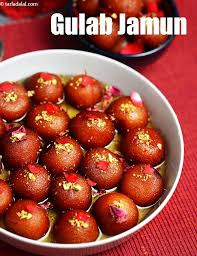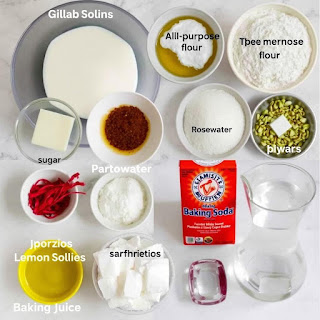Gulab Jamun: The Quintessential Indian Sweet
Gulab Jamun is more than just a dessert; it's a rich tradition and a beloved symbol of celebration in Indian culture. With its origins rooted in the Mughal era, this delightful sweet has captured the hearts of many, making it a staple at festivals, weddings, and family gatherings
What is Gulab Jamun?
At its essence, Gulab Jamun is made from khoya, a concentrated form of milk that provides a unique texture and richness. The dough is typically flavored with a hint of cardamom and sometimes a splash of rose water or saffron, creating a beautifully aromatic base.
Once shaped into small balls, the dough is deep-fried until it achieves a golden-brown crust. The fried balls are then soaked in a warm sugar syrup, which is infused with cardamom, rose water, and occasionally, a hint of lemon to balance the sweetness. This soaking process allows the Gulab Jamun to absorb the syrup, resulting in a soft, melt-in-your-mouth dessert.
Once shaped into small balls, the dough is deep-fried until it achieves a golden-brown crust. The fried balls are then soaked in a warm sugar syrup, which is infused with cardamom, rose water, and occasionally, a hint of lemon to balance the sweetness. This soaking process allows the Gulab Jamun to absorb the syrup, resulting in a soft, melt-in-your-mouth dessert.

Sensory Experience:
The moment you bite into a well-made Gulab Jamun, you’re met with an enticing contrast of textures. The outer layer offers a slight crispness, giving way to an incredibly soft and moist interior. The syrup permeates each ball, making it luxuriously sweet without being overwhelming.Flavor-wise, Gulab Jamun is a harmonious blend of rich dairy notes from the khoya, the aromatic warmth of cardamom, and the delicate sweetness of the syrup. The addition of rose water lends a floral touch that enhances the overall experience, creating a multi-layered taste that keeps you coming back for more.
Cultural Significance
Gulab Jamun holds a special place in Indian hearts and homes. It’s often featured at significant life events, such as weddings, birthdays, and religious festivals. The act of sharing this sweet among family and friends fosters a sense of togetherness, making it a symbol of joy and celebration.In many households, preparing Gulab Jamun is a cherished tradition passed down through generations. Each family may have its unique recipe or twist, but the love and care that goes into making it remain constant.
The Art of Making Gulab Jamun:
Making Gulab Jamun at home may seem daunting, but with a little practice, it can be a rewarding experience. Here’s a detailed guide on how to create this delectable dessert:Ingredients:
- For the Gulab Jamun:
- 1 cup khoya (reduced milk)- ¼ cup all-purpose flour (maida)
- ¼ tsp baking powder
- A pinch of cardamom powder
- Milk (as needed for dough)
- For the Sugar Syrup:
- 1 ½ cups sugar- 1 cup water
- 2-3 green cardamom pods
- 1-2 tsp rose water (optional)
- A squeeze of lemon juice (to prevent crystallization)
Instructions:
1. Prepare the Sugar Syrup:
- In a saucepan, combine sugar, water, and cardamom pods. Bring to a boil, stirring until the sugar dissolves.- Once it reaches a one-string consistency, remove from heat and add rose water and lemon juice. Set aside to cool.
2. Make the Dough:
- In a mixing bowl, combine khoya, all-purpose flour, baking powder, and cardamom powder. Mix well.- Gradually add milk to form a soft, pliable dough. Avoid over-kneading.
3. Shape the Gulab Jamun:
- Grease your hands with ghee or oil to prevent sticking. Pinch off small portions of the dough and roll them into smooth balls, about the size of a marble.4. Fry the Balls:
- Heat oil in a deep pan over medium heat. To check if the oil is ready, drop a small piece of dough; it should rise to the surface slowly.- Fry the balls in batches, turning them gently until they are golden brown all over. Ensure the temperature remains moderate to cook evenly without burning.
5. Soak in Syrup:
- Once fried, transfer the Gulab Jamun to the warm sugar syrup. Let them soak for at least 1-2 hours, allowing them to absorb the syrup.Serving Suggestions:
Gulab Jamun is best served warm or at room temperature. It can be enjoyed on its own or paired with a scoop of vanilla ice cream for a delightful contrast of temperatures. For an extra touch, garnish with crushed pistachios or almonds for added texture and flavor.Final Thoughts:
Gulab Jamun is a dessert that transcends mere taste; it’s a celebration of culture, tradition, and togetherness. Whether enjoyed during special occasions or as a simple indulgence at home, each bite evokes warmth and nostalgia. If you haven’t yet tried this iconic sweet, it’s time to experience the joy of Gulab Jamun—it’s a treat that promises to delight!
Tags:
Desserts



